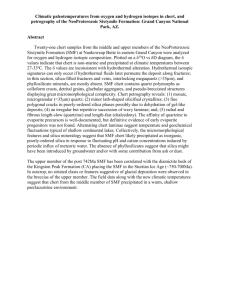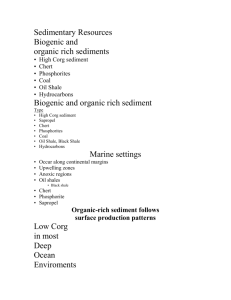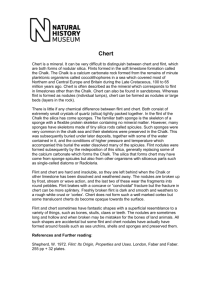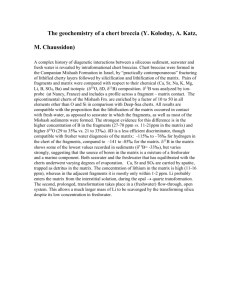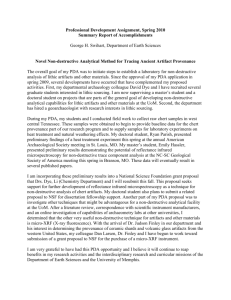to document number_25-Ft-Payne
advertisement
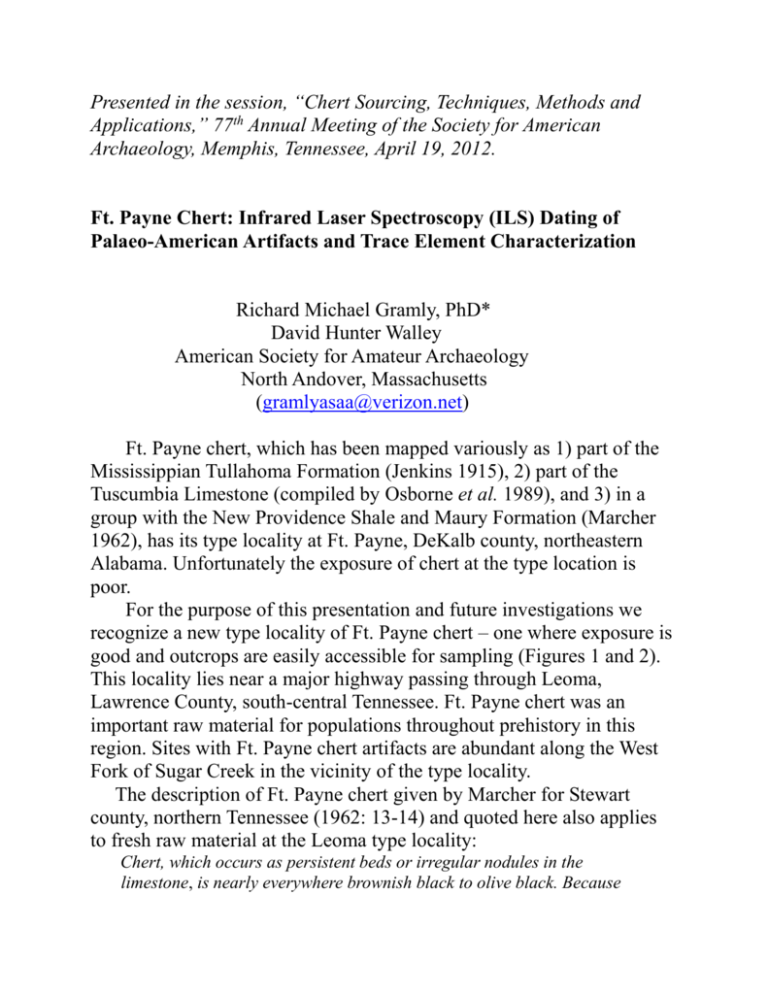
Presented in the session, “Chert Sourcing, Techniques, Methods and Applications,” 77th Annual Meeting of the Society for American Archaeology, Memphis, Tennessee, April 19, 2012. Ft. Payne Chert: Infrared Laser Spectroscopy (ILS) Dating of Palaeo-American Artifacts and Trace Element Characterization Richard Michael Gramly, PhD* David Hunter Walley American Society for Amateur Archaeology North Andover, Massachusetts (gramlyasaa@verizon.net) Ft. Payne chert, which has been mapped variously as 1) part of the Mississippian Tullahoma Formation (Jenkins 1915), 2) part of the Tuscumbia Limestone (compiled by Osborne et al. 1989), and 3) in a group with the New Providence Shale and Maury Formation (Marcher 1962), has its type locality at Ft. Payne, DeKalb county, northeastern Alabama. Unfortunately the exposure of chert at the type location is poor. For the purpose of this presentation and future investigations we recognize a new type locality of Ft. Payne chert – one where exposure is good and outcrops are easily accessible for sampling (Figures 1 and 2). This locality lies near a major highway passing through Leoma, Lawrence County, south-central Tennessee. Ft. Payne chert was an important raw material for populations throughout prehistory in this region. Sites with Ft. Payne chert artifacts are abundant along the West Fork of Sugar Creek in the vicinity of the type locality. The description of Ft. Payne chert given by Marcher for Stewart county, northern Tennessee (1962: 13-14) and quoted here also applies to fresh raw material at the Leoma type locality: Chert, which occurs as persistent beds or irregular nodules in the limestone, is nearly everywhere brownish black to olive black. Because of its dense and brittle character the chert fractures along irregular planes, producing angular pieces of all sizes. Under magnification the chert is very fine grained and fairly uniform in texture, much like the limestone. The silica is mostly cryptocrystalline, but small amounts of chalcedonic silica are present. Most of the chalcedonic silica occurs as irregularly-shaped spherulites randomly scattered through the rock. Brownish organic matter and finely disseminated iron oxides are abundant, much more so than in the limestone. Small carbonate rhombs are present but are rare. Small cubes and irregular masses of unaltered pyrite also occur, but most of them have been more or less oxidized. At the Leoma type locality fresh Ft. Payne chert is “medium dark gray (N4)” in color (Figure 3); while, chert that has been exposed to the elements for a few seasons lightens in color to “olive gray (5Y4/1)” or even “pale brown (5YR5/2)” – see USGS Rock-Color Chart (1975). After more than 13,000 years of weathering in the soils of Tennessee and northern Alabama, nearly all Palaeo-American flaked stone artifacts made of Ft. Payne chert have achieved a “light olive gray (5Y6/1)” or “yellowish gray (5Y7/2)" color sometimes with white mottling. Iron staining may partially mask old, color-bleached surfaces. The most abundant 12 elements in unweathered Ft. Payne chert from the Leoma type locality as determined by X-ray fluorescence are in descending order: Si, Ca, K, Fe, P, Sr, Ti, Zr, Cl, S, Ba and Sn. The range in per cent abundance is from 13.01 +/- 02 (Si) to .000043 +/- 2.4 or 43 +/- 2.4 parts per million (Sn). Apart from silicon, the chert is dominated by calcium, potassium and iron. It is interesting to note that the average abundance of barium in fresh, unweathered Ft. Payne chert is only 34-38 parts per million. This low value stands in marked contrast to the abundance of barium within the weathered rind of some ancient stone tools. We have measured concentrations 60-90 times the amount present in Ft. Payne chert fresh from the outcrop. Ft. Payne chert is well exposed in northern Alabama and centralwestern Tennessee. Without doubt it is the most important tool material in the archaeological record of that region (Miser 1921: 133) and adjacent northeastern Mississippi. To the south of the Ft. Payne zone and stratigraphically overlying it is another Mississippian-age formation with abundant chert – the Bangor Limestone (see Osbourne et al. 1989). Bangor chert, which is gray and translucent at thin edges when fresh, retains its color even after prolonged weathering. In that respect it resembles chert in the St. Louis and Ste. Genevieve formations, which are well exposed across Kentucky and northern Tennessee beyond the Ft. Payne zone (see for example, Shawe 1966). Discriminating visually between artifacts made of Ft. Payne chert versus artifacts fashioned of Bangor, St. Louis and Ste. Genevieve cherts does not appear to be a problem. However, our recent work with Middle Stage Cumberland artifacts from the Phil Stratton site that were assumed to be Ft. Payne chert has revealed significant variations (Figure 4). In short, quick visual inspection of weathered artifacts may confuse Ft. Payne chert with other raw material varieties. We emphasize the abundance of organic matter that has been observed in Ft. Payne chert by Marcher (1962). It reminds us of lignin-rich Knife River flint from the Dakotas. Both Ft. Payne and Knife River exhibit marked color change when weathered. We hypothesize that microscopic biogenic organisms find these raw materials to be nutritious and live within their surfaces. Further, we believe that these organisms may be responsible for some chemical and physical transformations during weathering. What Is Weathering? The characters of weathering rinds on cherts and other siliceous rocks have often been discussed; however, the processes that create them remain “complex and not well understood” (Wagner 1998: 301). In a general way, the net result is thought to be subtractive, that is, elements on the outside of a weathered rock become depleted leaving behind relatively higher amounts of less soluble components. Organic acids generated by decaying plants and carbonic acid in rain-water are thought to be responsible for dissolving rocks and liberating their ions. In certain soils and climates, chert may be leached throughout leaving few traces of its original composition and rendering it friable – good examples being Clovis-age artifacts from the Topper and Crosby Bay sites, South Carolina that are made of Coastal Plains chert (Charles McNutt and Christopher Moore, personal communication). In the case of Ft. Payne chert this elementary view of weathering cannot be the full story, as we have determined that some elements are enriched at the surface of ancient artifacts. Further, enrichment seems to increase over time – the most ancient specimens exhibiting the highest concentrations.. In Figure 5 are shown graphical outputs of elemental abundance for 1) raw Ft. Payne chert, 2) a weathered surface of a Clovis point made of Ft. Payne chert, and 3) a weathered surface of a Middle Stage Cumberland point of Ft. Payne chert. As we have observed for other samples, the raw Ft. Payne chert has low barium (50 ppm). On the other hand, the Clovis point was found to have 1,593 +/- 19 ppm; while, the Cumberland point yielded the result 3,157 +/- 22 ppm. In other words, the surface of the Clovis point was 32 times richer in barium than unweathered rock to be found within it. The Cumberland point’s surface was 63 times richer. Such impressive changes because of weathering call for an explanation. Irradiation of the barium-rich surfaces of Palaeo-American artifacts with sources of strong blue-light in the 440 nanometer range causes fluorescence in the yellow wavelength spectrum, as seen with the aid of suitable filters. This zone of fluorescence, 100-150 microns thick, is obvious at 500 magnifications (Figure 6). The substance(s) causing this type of fluorescence is unknown; likewise, its genesis can only be guessed. One speculation is that fluorescence is connected with anaerobic, microscopic, biogenic organisms living within the chert and nourished by abundant fossil organic remains. Their respiration requires the uptake of oxygen-rich salts – especially barium sulphate (aka barite or BaSO ). Barium ions excreted by these organisms during respiration might be fixed temporarily as barium sulphide; however, in the long run the action of carbonic acid in the environment would bind barium as a carbonate (witherite or BaCO ). One or another of these barium salts, perhaps in combination with other trace elements, may account for the yellow fluorescence of weathered Ft. Payne chert when it is stimulated by a 440 nanometer laser or other intense light source. That certain bacteria have the ability to “attack” relatively insoluble barite and liberate barium ions has practical applications when dealing with toxic by-products of drilling for petroleum (Krumholz 1999). Also, the bacterium Desulfovibrio desulfuricans has been shown to affect barite in sewage sludge (Baldi et al. 1996). Uptake of barium, perhaps resulting from bacterial action, has also been observed in decaying bones at Amboseli, Kenya (Trueman et al.2004). Therefore, it is not asking too much of our credulity to accept the idea that high levels of barium in weathered tools of Ft. Payne chert are caused by bacterial growth. Apart from barium enrichment, there are few other surprises when we compare elemental abundances in raw Ft. Payne chert with abundances in the rind of Cumberland fluted points. The amount of calcium within weathered Cumberland artifacts has decreased to as little as 1/20th the value in raw Ft. Payne chert; likewise, silica (Si) may be reduced by as much as 80%. Tin, zircon and sulphur disappear in weathered chert. Such changes may be understood as normal, subtractive, chemical weathering. On the other hand, there is a marked increase in molybdenum between raw Ft. Payne (zero – none present) and its weathered facies (271 +/- 22 parts per million). This change suggests that molybdenum, too, has been concentrated by bacteria. We hypothesize that the tetra-oxide, PbMoO , also may play a role in their respiration; we would expect a derivative salt to be deposited within the weathering rind. Thus, insofar as Ft. Payne chert is concerned, weathering is both subtractive and additive with biogenic organisms playing an important role. The build-up of dead organisms and their complex, barium-rich (and molybdenum-rich?) excreta within the weathering rind, we hypothesize, might provide some “traps” or “roosts” for atomic-sized particles to accumulate. If we could devise a means of measuring the amount of accumulated particles within ancient chert artifacts, we would have a means of dating them relatively. Radon in the Archaeological Record The element radon, atomic number 86, was discovered in 1900. At last count 36 isotopes were known – the number having increased by 10 since 1990 (Handbook of Chemistry and Physics, 1990 edition)! Of these many isotopes only Radon-222 is of practical concern as it has the longest half-life (3.8 days) and is a strong alpha-particle emitter. Radon222 originates with the radioactive decay of Uranium-238 via Thorium230 and Radium-226. Uranium and, thus, radon have an uneven distribution across North America. Alluvial soils, as a general rule, have small amounts of it; while, residual soils (upland soils) in un-glaciated regions can have a great deal. Alabama north of the Tennessee River, central Tennessee and central Kentucky exhibit relatively high radon values (EPA Map of Radon Zones) in both ground water and soil. Perhaps not coincidentally, this radon-rich region is underlain by Mississippian-age limestones and Ft. Payne chert. Buried chert artifacts come in close contact with radioactive radon dissolved in rain water, exposing them to energetic (5.6 MeV) alpha particles. Electrons in the outermost shells of atoms, we hypothesize, are “dislodged” by collisions with alpha particles and find temporary residences in traps within the chert. As we might expect, the upper surface of a buried artifact, which is fully exposed to radon in rain water, should have more dislodged electrons at an high-energy state than the downward-facing side of an artifact. This predicted difference or “sidedness” has, in fact, been observed repeatedly by us. The absence of such “sidedness” is a strong argument against the authenticity of a bogus archaeological specimen. In addition to the effects of radon, electrons may be boosted to higher-energy traps by atomic particles and gamma radiation from decaying radioactive elements that pre-exist within the chert itself and the environment surrounding it. The techniques of thermo-luminescent (TL) dating and optically stimulated luminescent-dating (OSL) are predicated upon this assumption. However, radon in water, we hypothesize, is primarily responsible for the accumulation of highenergy electrons within the weathered rind of cherts – and particularly Ft. Payne chert. Unlike other researchers who view radon damage as a nuisance and an impediment to their dating techniques (e.g., Richter and Krbetscher 2006: 695), we embrace it. Raman Fluorescence, Stokes Scattering, and Measuring Age In 1928 C. V. Raman and K. S. Krishman, as well as other scholars working independently, observed that some monochromatic light reflected back from a target had shifted frequency. Eventually it was established that many elemental bonds fluoresced when bathed in strong monochromatic light. Further, the wavelength “signatures” of fluorescing bonds were a means of testing for the presence of specific elements and gauging purity – as in the case of diamonds. Graphs of fluorescing light yielded by carbon-carbon bonds of pure diamonds are strong and sharp (see, for example Figure 7); while impure diamonds yield a less focused output, that is to say, a light of greater band width. These days lasers are the source of narrow band-width energy used to stimulate fluorescence. Infrared lasers generate Raman fluorescence equally as well as or better than lasers that emit shorter wavelengths of the visible spectrum; however, analysts have observed an unwelcome side-effect known as Stokes scattering. An infrared laser is particularly effective in causing high-energy electrons, which have accumulated in traps within rocks and minerals by exposure to radon, to fall to lower energy states. When they fall, photons are emitted.. This scattering – Stokes scattering – may even be powerful enough to over-ride and obscure actual Raman signatures. Rocks and minerals targeted by an infrared laser (We have employed a laser with a wavelength of 785-786 nanometers) will begin to glow and then fade as their high-energy electrons are dislodged and fall back to more tightly bound positions within atomic arrays. Using a detector (charge-coupled device or CCD), the glow may be measured and recorded graphically. A typical output is shown by Figure 8. The accumulation of high-energy electrons within the weathered zone of ancient artifacts made of Ft. Payne chert is greater than we have observed for many other chert varieties. In other words, electrons boosted from low-energy states by the radioactive decay of radon find many traps to occupy in Ft. Payne chert as compared to some other raw materials. Since the measured light output from weathered Ft. Payne chert is strong enough to override most Raman emissions, it becomes an ideal substance for relative dating. Stokes scattering may also be observed throughout the unweathered interior of artifacts; however, light output is much reduced compared to the chemically and physically altered outer rind. The contrast in intensity between light emitted from a rock’s interior versus exterior when stimulated by an infrared laser is a recently patented means of authenticating artifacts (Walley, n.d.; also US patent Number 8134133, March 13, 2012). If there is no contrast in light values for the exterior vs. interior, one must conclude that the object is unweathered and has been manufactured modernly. Also, by employing a laser beam with a “virtual focus,” it is possible to measure Stokes scattering within an artifact without destructive cutting or drilling. Such capability should be a boon to museum curators and scientists everywhere. Applications Like any other method of dating archaeological remains, investigators must select samples for infrared laser spectroscopy (ILS) with care if good results are to be achieved. Heavily abraded specimens from an active beach or a sand bar in a river channel are poor candidates for ILS dating, as their weathered rinds with high-energy electrons may be truncated. Likewise, an artifact on the ground surface that has been subjected to brush fires cannot be expected to generate a light reading bearing upon its age of manufacture. Something must also be known about the soils where artifacts for dating are collected. Were they found within alluvium, glacial debris, or at un-glaciated, upland locations? Ft. Payne chert artifacts of the same type but from different soils, we have observed, yield significantly different light values. Also, perhaps it goes without saying, artifacts thought to be the same age or belonging to the same archaeological culture but made of different raw materials may produce different light values. Armed with these understandings, we may discriminate among unburned artifacts from equivalent soils that are assumed to be of identical raw material. At the Phil Stratton Cumberland site in Logan county, western Kentucky, “look-alike” flaked tools – all thought initially to have been made of Ft. Payne chert with predictably high light values – were determined to represent two or more lithic populations. The small group of artifacts shown in Figure 4 yielded light values of 37,000 - 52,000 units and 24,000 - 30,000 units – with an outlier specimen (modernly burned?) showing only 14,000 units. Upon closer inspection, the specimens with a lower light value appear to have a similar fabric, are more gray in color, and are more translucent than what we might expect for Ft. Payne chert within its region of outcrop. A simple demonstration of the utility of ILS relative dating is provided by three artifacts that were collected in 2011 from the plowed surface of a prehistoric site at Bates Pond, near Leighton, Colbert county, northern Alabama (Figure 9). All three were fashioned of Ft. Payne chert, weathered similarly, were unburned and exhibited slight iron staining. Two of these specimens – a trianguloid endscraper and a basal fragment of a fluted point preform – are Clovis in age; while, the third is a medial fragment of an Early Archaic projectile point of the Lost Lake type. Averaged measurements of light intensity for both sides of the three specimens are tabulated below: Table. ILS Measurements of Prehistoric Flaked Tools of Ft. Payne Chert From the Bates Pond Beach Site, Colbert County, Alabama Clovis Preform Base Side A Side B 66,250 109,500 76,250 51,250 87,750 54,000 84,500 75,000 71,500 91,500 Clovis Endscraper Side A Side B 77,250 94,500 80,750 52,000 51,500 102,750 89,750 70,750 77,250 74,250 Lost Lake Point Side A Side B 50,000 61,500 50,000 64,500 57,250 50,700 66,000 48,750 50,000 59,000 77,250 76,250 Both sides = 76,750 75,300 78,850 Both sides = 76,175 54,650 56,800 Both sides = 55,725 Assuming that the Clovis artifacts are 13,000 calendar years old and solving the equation 55,725/76,460 = 13,000/X for X, we arrive at an estimated calendar age for the Lost Lake point of 9,474 calendar years. This result is in keeping with the range of radiocarbon ages for all manner of Lost Lake points (9,000-7,500 RCYBP); see Perino 1986: 232), having a median age of 8,250 RCYBP. Such a median age is equivalent to 9,240 calendar years – an excellent fit with the experimental ILS date. Another application of ILS dating to an archaeological assemblage involves a series of 22 Ft. Payne chert projectile points or knives known to be from the surface of the Heaven’s Half Acre site (aka, 6th Street site) near Leighton, Colbert county, northern Alabama. This extensive site, which encompasses a cluster of discrete and sometimes overlapping habitation loci, has yielded many thousands of Palaeo-American and Very Early Archaic flaked stone tools since the 1960s (King 2007). It occupies upland, karstic topography that is well away from the modern floodplain of the Tennessee River or any of its tributaries. After typing the assemblage, an averaged light value was obtained for each specimen. Five readings on both faces were made. Four Late Stage Cumberland points with no evidence of heat damage yielded the group mean 69,075 light units (range 65,275 - 72,250); while, the mean light unit value for 12 Clovis points was found to be 71,982 (range 59,525 - 94,950). Since these means are very close, there appears to be no demonstrable age difference between Clovis and Late Stage Cumberland at the Heaven’s Half Acre locality. Interesting to note, two Very Early Archaic points among the assemblage were found to have va1ues of only 58,050 light units (Greenbrier point) and 41,800 (Beaver Lake point). These results suggest a more recent age for the points, as one might expect. An adequate test of the utility of ILS dating requires large samples of Ft. Payne chert artifacts falling within recognizable types. In practice, it is challenging to obtain artifacts with sound, detailed provenience from private collectors and even most museums. Yet, the quest for large, trustworthy samples must not cease as some fresh truths might be revealed. We end our presentation with the outcome of ILS testing upon a group of 19 Cumberland (N = 11) and Clovis (N = 8) fluted points made of Ft. Payne chert from upland findspots in Lawrence county, Tennessee – the very same county where our new type locality for Ft. Payne chert is located. These Cumberland points belong to the earliest two stages of a long-lived Cumberland Tradition (Gramly 2010, 2012) and are easily segregated by their attributes from Late Stage Cumberland points – such as those at the Heaven’s Half Acre site. We found that the group of Clovis points yielded only 75% of the light value recorded for the 11 Cumberland specimens (also see McNutt, Cherry, and Walley 2010 for a discussion of this outcome). Relative to Clovis, the earliest stage of the Cumberland Tradition may be as much as 3,000 years older. In a general way, this finding is in harmony with the higher barium abundance for Cumberland points of Ft. Payne chert compared to Clovis (Figure 5). On these grounds alone, yet not forgetting the small size of our measured sample, we suggest that Cumberland has older roots than Clovis. It is remarkable to think that the long-sought evidence for a “preClovis” phase has always been before us – hiding in plain sight as a Cumberland point! Acknowledgments We thank Doug Puckett of Muscle Shoals, AL and other amateur archaeologists in Lawrence county, TN who furnished Ft. Payne chert artifacts for ILS relative dating. *Address all enquiries to the senior author who bears all responsibility for any shortcomings of this paper. REFERENCES Baldi, Franco, Milva Pepi, Daniela Burrini, Goran Kniewald, Daniela Scali, and Eudes Lanciotti 1996 Dissolution of barium from barite in sewage sludges and cultures of Desulfovibrio desulfuricans. Applied and Environmental Microbiology 62(7): 2398-2404. Gramly, Richard Michael. 2010 Origin and Evolution of the Cumberland Palaeo-American Tradition. Persimmon Press. North Andover, Massachusetts. 2012 Bifaces of the Cumberland Tradition. Persimmon Press. North Andover, Massachusetts. Jenkins, Olaf P. (compiler) 1915 Geologic Map of Tennessee. State Geological Survey. Nashville. King, Howard 2007 Heaven’s Half Acre. Stones & Bones 49(4):1-7. The Alabama Archaeological Society. Marcher, Melvin V. 1962 Geology of the Dover Area, Stewart County, Tennessee. Division of Geology, Report of Investigations 16. Department of Conservation and Commerce. Nashville. McNutt, Charles H., James F, Cherry, and David H. Walley 2010 A Double-Blind Test of the Walley IR Raman Laser Technique for Relative Dating of Lithics (with comments upon Detection of Modern Replicas). Posting on the website www.monah.us. Miser, Hugh D. 1921 Mineral Resources of the Waynesboro Quadrangle, Tennessee. State Geological Survey Bulletin 26. Nashville. Osborne, W. Edward, Michael W. Szabo, Charles W. Copeland, Jr. and Thornton L. Neathery (compilers) 1989 Geologic Map of Alabama (Special Map 221). Montgomery. Perino. Gregory 1985 Selected Preforms, Points and Knives of the North American Indians. Idabel, Oklahoma. Richter, D and M. Krbetscher 2006 A new thermoluminescence dating technique for heated flint. Archaeometry 48(4): 696-705. Shawe, Fred R. 1966 Geologic Map of the Dot Quadrangle, Kentucky-Tennessee. Kentucky Geological Survey. Frankfort. Trueman, Clive N. G., Anna K. Behrensmeyer, Noreen Tuross, and Steve Weiner 2004 Mineralogical and compositional changes in bones exposed on soil surfaces in Ambolseli National Park, Kenya: Diagnostic mechanisms and the role of sediment pore fluids. Journal of Archaeological Science 31: 721-739. Wagner, Gunther A. 1998 Age Determination of Young Rocks and Artifacts. (Translated from the German). Springer Verlag. Heidelburg. Walley, David Hunter N.d. Provisional Application of David Hunter Walley for United States Letters Patent on Method and System for Authenticating Archeological Artifacts. Filed with Michael D. Eisenberg, Attorney. Captions for Figures: Figure 1. Seam of Ft. Payne chert in the bed of the West Fork of Sugar Creek, on the farm of Mr. and Mrs. Charles Edmunds, 276 Old Florence-Pulaski Road, southeast of Leoma, Lawrence county, Tennessee. R. M. Gramly photograph. Figure 2. Map of east-central Lawrence county, Tennessee showing location of new Ft. Payne chert type locality. Figure 3. Colors of Ft. Payne chert. A, freshly-broken, dark gray; B, slightly weathered, olive gray; C, slightly weathered, pale brown; D, severely weathered, light olive gray; E, severely weathered, yellowish gray and partially iron-stained. A-C, Leoma type locality; D, Palaeo-American burin, from “Brambly Bottom,” Shoal Creek, Lawrence county, TN; E, Palaeo-American unifacial tool, Heaven’s Half Acre site, Colbert county, AL. R. M. Gramly photograph. Figure 4. Series of nine Palaeo-American flaked stone tools from the Phil Stratton site, Logan county, Kentucky. By visual inspection they were thought to be Ft. Payne chert. Examination with an infrared laser spectrometer, however, revealed that stored light values varied and that other chert(s) in addition to Ft. Payne may be represented. A, sidescraper and graver (P.S.1952), average 37, 124 light units; B, hollow scraper/beak on core tablet (P.S.-136), avg. 40,125 l.u.; C, beak on fragmentary sidescraper (P.S.-2051), avg. 13,583 l.u.; D, combination tool (P.S.-1327/1906), avg. 38,166 l.u.; E, tool fragment (P.S.1465), avg. 30,416 l.u.; F, tool fragment (P.S.-3), avg. 51,875 l.u.; G, beak (P.S.-1683), avg. 27,958 l.u.; H, utilized flake/ graver (P.S.-1653), avg. 20,333 l.u.; I, possible graver (P.S.171), avg. 24,208 l.u. R. M. Gramly photograph. Figure 5. Relative abundance of barium (peaks marked with an arrow) as determined by X-ray fluorescence for A) raw Ft. Payne chert, B) weathered rind of a Clovis point of Ft. Payne chert, and C) weathered rind of a Cumberland point. Operator: David Walley using a SpectroXepos (TM). polarized tube device. Figure 6. View at 500X of the edge of a cross-sectioned Middle Stage Cumberland point of Ft. Payne chert showing yellowfluorescing, weathered rind 100-150 microns thick and unweathered interior that fluoresces orange (caused by calcite). David Walley photograph. Figure 7. Raman spectrum generated for gem-quality diamond excited at room temperature by a laser with a wavelength of 228.9 nanometers (nanometer = 1 X 10 meter). Arrow indicates primary peak. From rsta.royalsocietypublishing.org, 3/5/2009. Figure 8. A: Output of incidental energy or Stokes scattering (areas under curved lines) for both sides of an authentic Texas chert knife that has been stimulated by a 785 nm laser. Note similar shape of curves but the marked difference in amplitude. The curves for a modern reproduction will be nearly identical in amplitude, sometimes flatter, and may exhibit peaks of Raman fluorescence for specific atomic bonds. B, Generalized portrayal of Raman signals only – showing no Stokes scattering. Figure 9. Relatively dated artifacts of weathered Ft. Payne chert from the Bates Pond Beach site, near Leighton, Colbert county, Alabama. A, Clovis preform base and trianguloid endscraper; B, medial section of a Lost Lake point showing resharpening by beveling. R. M. Gramly photograph.
